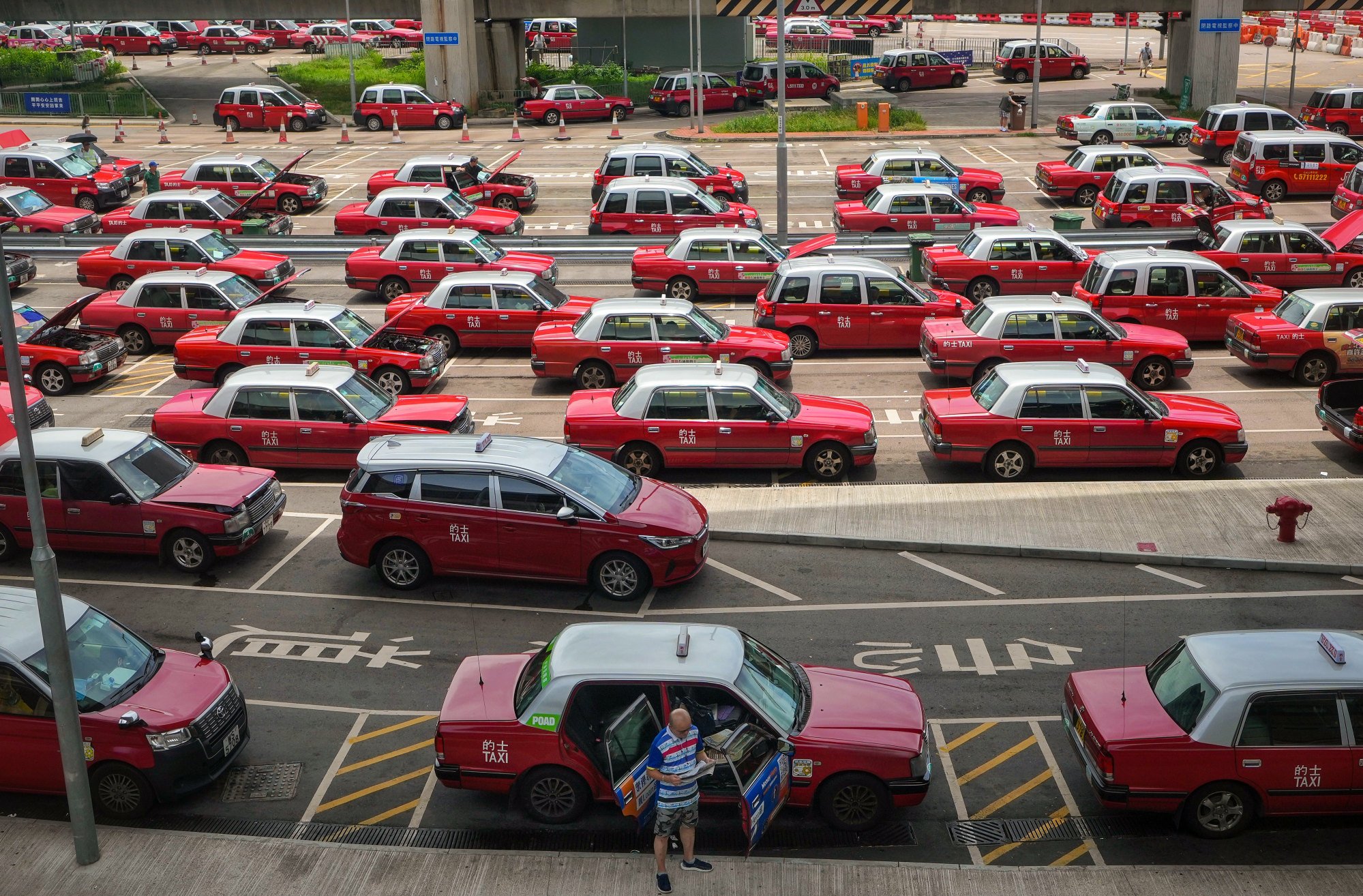Hong Kong’s ride-hailing firms are seeing a light at the end of the tunnel after more than a decade of operating mostly illegally and locking horns with the taxi industry.
Secretary for Transport and Logistics Mable Chan is intent on legalising ride-hailing and opening the sector to all players.
A framework for regulating the platforms is expected to go before lawmakers this year and, going by the experience of other jurisdictions, Hong Kong is unlikely to limit the number of ride-hailing operators.
Do you have questions about the biggest topics and trends from around the world? Get the answers with SCMP Knowledge, our new platform of curated content with explainers, FAQs, analyses and infographics brought to you by our award-winning team.
Experts told the Post that the new regulations, aside from covering the safety and security of users, should ensure a level playing field for taxis and ride-hailing platforms, and safeguard cabbies’ livelihoods too.
But the taxi sector’s opposition to the platforms was on display again this week, as an influential union for cabbies threatened to lead a five-day strike next month if authorities failed to respond positively to its demands for a clampdown on the apps.
US-based Uber arrived in the city in 2014 and quickly became hugely popular with commuters who were fed up with the poor taxi service, including rude cabbies and uncomfortable rides with ageing drivers.
Three other ride-hailing platforms have joined the scene since then – Singapore-based Tada, Chinese navigation app Amap and Beijing-based Didi Chuxing. Amap is operated by Alibaba Group Holding, which owns the South China Morning Post.
All this time, however, it has been illegal for drivers of private vehicles to accept paid customers without a hire-car permit and the platforms have operated mostly unregulated.
They have faced never-ending objections from the city’s cabbies, who have complained bitterly about stiff competition, loss of earnings and what they consider to be an unfair state of play.
At the core of their unhappiness has been the high cost of securing a taxi licence, a tradeable commodity that changes hands for millions of Hong Kong dollars. In 2024, tensions escalated as cabbies went undercover to report unlawful ride-hailing services to police.
Unlike metered taxi fares, the ride-hailing platforms charge differently throughout the day, with prices surging at peak times.
Chan, who took over as transport minister in December last year, revealed in January that a working group under the government’s Transport Advisory Committee would meet the four ride-hailing service operators in February.

She also said the government would engage cabbies, who were likely to resist the latest developments.
Professor Alejandro Reyes, from the University of Hong Kong’s department of politics and public administration, welcomed the government’s move to regulate the sector, but told the Post it was important for ride-hailing platforms and taxis to have a level playing field.
“Ride-hailing cars should have to meet all the licensing requirements and costs entailed, comparable to taxis,” said Reyes, who is a long-time user of ride-hailing platforms.
He said regulation should not only ensure the safety and security of passengers, but also ensure that platform drivers and cabbies meet the same requirements.
“Are the regulations imposed on both taxis and ride-hailing services going to ensure safety, security and a decent, clean, sanitised environment for their users?” he said. “If they achieve that across both streams of ride services, that should be adequate.”
‘Avoid sudden disruptions’
Hong Kong has taken longer than others in coming to terms with the public transport disruption brought about by the likes of Uber.
From mainland China to Singapore, Australia and the United States, authorities have introduced regulations for ride-hailing platforms, with licensing systems, permits and insurance requirements.
Associate Professor Walter Theseira, head of the Singapore University of Social Sciences’ urban transport programme, cautioned that in introducing regulation, Hong Kong should avoid sudden disruptions that affect the financial stability of cabbies owning tradeable taxi licences.
He pointed to New York, where a limited number of prized taxi licences also changed hands at a premium, and how Uber’s arrival there in 2011 resulted in grief among cabbies as ride-hailing took off.
There were cases of taxi licence owners in financial distress and some were reported to have killed themselves. “Some had borrowed a lot of money to get them,” he said.
In 2017, the New York Taxi Worker Alliance blamed six suicides in seven months on cabbies facing overwhelming financial pressures and competition from ride-hailing apps.
To operate there, ride-hailing platforms must have a permit, and drivers have to obtain the same driving licence as cabbies. Their vehicles have to be approved for ride-sharing use and their numbers are subject to a partial limit.
Theseira said the situation was different in Singapore, which had no tradeable taxi licences.
Those interested in providing ride-hailing services there could simply convert their personal car into a licensed private hire vehicle by meeting inspection requirements, obtaining commercial insurance for ride-hailing and displaying a designated sticker.
“Ride-hailing platforms entered Singapore first by offering booking services because people complained that they could not find a taxi when they wanted one,” Theseira said.
The scene has changed significantly over the past decade. There are now eight ride-hailing platforms, including the city state’s main taxi companies whose drivers also accept bookings via their apps.
The number of taxis has shrunk, with people so used to booking a ride from point to point via the apps that hailing a cab on the street has become rarer.
In December 2024, just over one in 10 point-to-point journeys in Singapore were street-hail trips, down from almost two in 10 in the same month in 2021, according to official data. Most journeys were ride-hail trips.
Many agree that the arrival of ride-hailing forced Singapore’s taxi industry to shape up on service.
The city state has no limit on individual licences for taxis or private hire cars as long a driver has the necessary insurance and meets the inspection and registration requirements.
“The reason the government has not controlled the numbers is that it feels it is better for the market to determine the correct level of supply, based on what people are willing to pay and the demand,” Theseira said.
In Australia, the ride-hailing phenomenon forced Sydney’s taxi industry to be more competitive by improving service, said David Hensher, professor and founding director of the University of Sydney Business School’s Institute of Transport and Logistics Studies.
In 2019, more than 8,000 taxi drivers and hire-car owners collectively took legal action, claiming significant income and licence value losses due to Uber’s entry into Australia in 2012. Uber settled the lawsuit last year for A$271.8 million (US$170.7 million).
Since Uber’s arrival, however, Sydney taxis have adopted a similar booking system without surge pricing to keep an edge, with fares settled after the trip. Some cab services improved with better quality vehicles, uniformed drivers, cleanliness and dependable booking systems.
Hensher said: “Uber made the taxi industry rethink its future and improve its service, vehicle quality and booking reliability. Taxis have gained back some market share, but recognise now they need to improve and maintain quality service.”
‘No need for ride-hailing’
In Hong Kong, it is currently illegal for drivers of private vehicles to accept paid customers without a hire-car permit, with the number of permits capped at 1,500.
In 2021, when only 1,115 such permits were issued by the government, Uber and Uber Taxi had more than 216,000 registered drivers. Uber Taxi is legal because its vehicles have the relevant permits.
Hong Kong has 46,000 taxi drivers and about 18,200 cabs on the road.
Cabbies are not thrilled by the government’s moves to regulate ride-hailing.
Hong Kong Taxi Owners’ Association chairman Wong Po-keung, 77, a cabby and taxi licence owner, was firmly against adding more ride-hailing services.
“Taxi drivers are already struggling to make a living. The government should refrain from expanding the operation of additional ride-hailing services,” he said.
He was particularly concerned about cabbies who paid large amounts for their licences. The price of a licence combined with a taxi hit a record HK$7.66 million in 2009, but has since come down and was about HK$2.86 million this month.
“Introducing more services could profoundly affect us licence holders,” he said.
Ryan Wong Cheuk-pong, chairman of the Hong Kong Taxi Council industry body, was opposed to ride-hailing and questioned its place in the public-transport landscape.
“For long-distance trips, our government’s current policy is to use our railway network as the backbone,” he said. “Places not covered by rail would be covered by buses. When passengers arrive at public transport interchanges, they can change to minibuses to get to their destination.”
In that scenario, he said, taxis supplemented other public transport operators to meet the needs of those demanding point-to-point service.
If ride-hailing was legalised and more cars joined the platforms, they would add to congestion and pollution, he added.
Cabby Kenny Liu Wai-kin, 39, who paid almost HK$3 million for his licence in 2022, was more amenable to change, but hoped the regulations would be fair in terms of insurance coverage and the examinations drivers sit.
He found it unfair that practically any driver could join the currently illegal ride-hailing scene by simply using a HK$60,000 second-hand private car and paying about HK$5,000 for insurance.
“But we invested a fortune to get a licence to run legally and commercially and pay an annual premium of about HK$50,000,” he said.
On top of that, those who want to become cabbies must sit a 45-minute exam – making no more than nine mistakes answering 60 multiple-choice questions – and attend a pre-service course.
“In terms of regulation, at the very least, the insurance for ride-hailing services should be on par with that for taxis. Those drivers also need to go through the same examination,” Liu said.
He expected the value of taxi licences would erode, but felt that raising the thresholds for ride-hailing would prevent a sudden expansion of such vehicles and help maintain cabbies’ competitiveness.
Academic Theseira said ride-hailing regulations should focus on safety through licensing, insurance and market conduct in terms of pricing transparency.
“I would look at pricing in the form of commissions and charges that the platforms charge the drivers,” he said. “The most important thing is to ensure there’s reasonable competition, because it’s very hard for any authority to say what is the correct fare.”
The hope was that competition would bring fares, commissions and charges to a level appropriate for market conditions.
“If you have a very large player, you have to look at whether its conduct is problematic or abusive in some ways which may be anticompetitive,” he said.
While he did not think fares should be regulated, he said there should be rules to cover pricing transparency, driver commissions and trip costs so that charges would not change once ride bookings were confirmed.

‘Quality of service matters’
Lawmaker Gary Zhang Xinyu, who sits on the Legislative Council’s transport affairs panel, commended authorities and said they had put residents’ needs first, while he stressed that regulation must cover both platforms and vehicles.
In managing the platforms, the focus should be on the quality of service.
“When regulating vehicle permits, the emphasis is on quantity. For a more comprehensive approach, regulating both elements is essential,” he said.
To safeguard the competitiveness of taxi drivers, Hong Kong should watch not only the number of licences for ride-hailing vehicles, but also regulate the proliferation of full-time ride-hailing drivers.
He said the mainland faced a challenge as ride-hailing services appeared increasingly similar to taxi operations, moving away from the fundamental concept of supply adjusting flexibly to changes in demand.
“The mainland’s ride-hailing model involves conglomerates or owners purchasing numerous ride-hailing vehicles, which are then rented to drivers. The operations closely resemble the traditional taxi mode, with these vehicles operating all day,” Zhang said.
The result was an oversupply that hurt both ride-hailing drivers and cabbies. “We can’t let this situation happen in Hong Kong,” he said.
Regulating service hours for e-hailing drivers might be the way to maintain a healthy and balanced transport capacity, allowing cabbies to earn stable incomes too.
“When their income is stable, rental prices follow suit. This stability extends to the value of taxi licences,” he said.
Ride-hailing operators, meanwhile, hoped for balance and cooperation as authorities went about regulating the platforms.
Welcoming the moves, Uber Hong Kong general manager Estyn Chung said: “We believe a balanced regulatory framework can ensure rider safety and service quality while preserving the flexibility and earning opportunities that drivers value.”
He added that Uber’s experience elsewhere had shown that taxis and ride-sharing could not only coexist but also thrive “under fair and reasonable regulations”.
Tada, in Hong Kong since 2024, told the Post that regulators in Southeast Asia had taken a “more studied and collaborative approach to craft regulations that balance innovation with public interest”.
A spokesman said: “These frameworks fostered a win-win environment for stakeholders, prioritising safety, fairness and sustainability.”
The ride-hailing firm, operating in several Asian regions, said introducing effective regulations for the sector was a gradual process requiring “extensive engagement” and had to evolve with the needs of the commuting public.
“By prioritising public needs and encouraging cooperation, Hong Kong can develop a framework that benefits all stakeholders and supports a thriving, sustainable transport ecosystem,” the spokesman said.
Quentin Cheng Hin-kei, a spokesman for commuter concern group Public Transport Research Team, hoped the regulatory regime would safeguard the rights of ride-hailing drivers too.
“This is a great move for passengers as regulations will not only provide convenience but also assure their safety with relevant insurance,” he said.
“However, I am worried that the rights of ride-hailing drivers may be exploited due to the growth of the platform. The government’s regulation should also focus on levelling the playing field in terms of commission rates.”
That was also a concern of Jack Leung*, 48, an IT consultant and part-time Uber driver, who worried that the dominance of ride-hailing platforms might result in higher platform fees or fewer long-distance rides allocated to drivers.
But he thought the government action was long overdue.
“Regulations are beneficial as they ensure everyone understands the rules of the game,” he said.
“I don’t mind going through background checks, buying the required insurance or having limited working hours because I truly believe taxi and ride-hailing customers do not directly overlap.”
*Name changed at interviewee’s request.
More from South China Morning Post:
- Hong Kong taxi union threatens 5-day strike if city fails to clamp down on Uber
- Hong Kong cab-hailing app HKTaxi to shut down and migrate drivers to owner Uber
- From regulating Uber to combating space oil, what Hongkongers can expect in 2025
For the latest news from the South China Morning Post download our mobile app. Copyright 2025.





